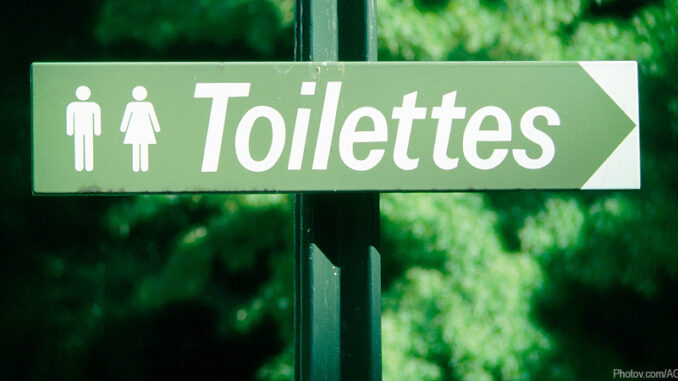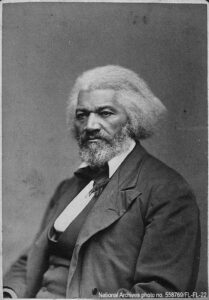
Revising History

On February 1, at an address honoring Black History Month, President Trump talked about several important African American figures in history, before saying something surprising that almost immediately drew widespread criticism: “Frederick Douglass is an example of somebody who’s done an amazing job, and that is being recognized more and more, I notice,” he said. Douglass, a formerly enslaved person who became a gifted orator and notable activist and abolitionist, died in 1895. However, the way Trump talked about him made people question if the president thought Douglass were still alive.
The next day, Kellyanne Conway, one of Trump’s top advisers, made news of her own. During an interview with MSNBC, she defended Trump’s so-called “Muslim ban” by saying that Obama had done the same thing during his administration, when he closed the nation’s doors to Iraqi refugees because the Bowling Green Massacre was masterminded by two Iraqi nationals.
The problem? No Bowling Green Massacre ever occurred.
Later, Conway apologized, saying that she misspoke and had meant to say “terrorists” instead of “massacre.” It’s true that two Iraqi nationals living in Bowling Green, Kentucky, attempted to send weapons and money to al-Qaeda to kill U.S. soldiers in Iraq. But no attack ever took place on U.S. soil. Both men were arrested, but neither was charged with attempting any terrorist attacks in the United States. Though Conway claims that she made a simple mistake, this isn’t completely true: she also cited the Bowling Green Massacre during recent interviews with both Cosmopolitan magazine and TMZ.
Conway’s mistake matters because of the issue of credibility. During an era of “fake news” and “alternative facts,” the Bowling Green story add more concern that controversial decisions and executive policy (such as the Muslim ban) is being made on a shaky data. Some of the most outspoken media watchdogs have urged news networks to stop booking Conway because she is no longer seen as a credible source.
What Do You Think? People have responded to Conway’s mistake by creating false memorials to the Bowling Green Massacre, writing songs about it, creating T-shirts, and even holding candlelight vigils, often using the slogan “Never Remember.” Why do you think people have responded this way? What effect do you think these actions have on how the public views Trump and his administration?
Where is Melania Trump?
Two days after her husband’s inauguration, Melania Trump departed Washington D.C. for her home in New York City, and has not been seen in the capital city since, leading to speculation about whether or not she will ever move to the White House, and causing many to question what kind of first lady Mrs. Trump aspires to be.
Traditionally, first ladies assemble a staff well before Inauguration Day, but Mrs. Trump only announced her first staff pick last Wednesday: Lindsay Reynolds, who will serve as chief of staff of the East Wing. The first lady’s office is responsible for running White House tours, but thousands of tour requests have been piling up, unanswered. Critics wonder how much planning, if any, has gone into two important upcoming events which also are run by the first lady: the black-tie Governors Ball at the end of February, and the Easter Egg Roll, which draws about 35,000 people every year. Mrs. Trump has stated that she plans to tackle the issue of cyberbullying while first lady, but so far no specific plans have been outlined. She has also not yet developed a social calendar for the White House, nor has she appointed a social secretary.
Perhaps this should not be a surprise. Mrs. Trump announced last year that she would not move to the White House right away and would instead remain in New York while the Trumps’ ten-year-old son, Barron, finishes the school year. After that, she says she has every intention of joining her husband in Washington full time. In addition to appointing Lindsay Reynolds to her team, she also chose interior designer Tham Kannalikham to redo the White House living quarters. Mrs. Trump plans to announce more appointments to her staff in the coming days.
Dig Deeper Using Internet resources, look up the approval rating of the five most recent first ladies–Michelle Obama, Laura Bush, Hillary Clinton, Barbara Bush, and Nancy Reagan. Who had the highest approval rating when her husband took office? The lowest? Who was the most popular upon leaving office? The least popular? Based on your data, can you draw any conclusions about how the approval rating of first ladies changes during their husbands’ time in office?
Hollywood's Blacklist
When you hear the phrase “Hollywood Blacklist,” do you think of the actors, directors, and screenwriters who were denied work in the 1950s because they were suspected of being Communists? Turns out, the Hollywood Black List is alive and well . . . though maybe not in the way you thought it was.
Invented by a young film industry executive named Franklin Howard in 2005, Hollywood’s Black List is actually an anonymous annual survey of the year’s best film scripts, whether or not they have actually been made, which is published on the second Friday of December. The goal is to round up a diverse list of the year’s best-written, most compelling scripts, not necessarily the ones that will make the most money at the box office. About a third of Black List scripts are made into movies every year, and many of those go on to win Oscars and other awards. It is meant to counteract the number of sequels and comic book blockbusters made in Hollywood. Black List films have been nominated for 241 Academy Awards and 205 Golden Globe Awards, and have included such modern-day classics as Slumdog Millionaire and Juno.
This year, the top script on the Black List is Blond Ambition, a film about Madonna’s struggles to get her first album released in the 1980s. Other top scripts include Life Itself, The Olympian, The Post, and Voyagers.
Dig Deeper In 2005, Franklin Leonard emailed about 90 other development executives and asked them to name the ten best unproduced screenplays they read that year. He then compiled the list and sent it to everyone who responded, and the first Black List was born. Create your own Black List by asking ten friends or family members to list the best movies they saw in 2016, and rank the results according to how many votes each one receives. How does your 2016 Black List compare to Hollywood’s?
Paris' Peeing Problem
Public urination is a problem in cities around the world. It damages lamp posts and telephone poles, ruins paint, pollutes water sources, and smells terrible, especially in summer. Recently in San Francisco, a street lamp whose base was damaged from urine collapsed and almost hit a driver. The city of Paris has been working to combat the problem for years, installing 400 free, unisex public toilets in 2006 and spending millions employing sanitation workers to clean and deodorize the streets every month. They have also raised the fine for public urination to roughly the equivalent of $75. But it’s still not enough, with the number of known incidents in Paris increasing from 2,189 in 2014 to 2,511 in 2016. Now, the city has come up with a new solution: the Uritrottoir.
The Uritrottoir is an eco-friendly public toilet. It is a large box with an opening in the front, covered in bright red graffiti-proof paint, and its top section is also a flower or plant holder. Instead of using water, the toilet contains a bed of dry straw, sawdust, or wood chips. The carbon in the organic matter helps eliminate the odor of the urine. When the toilet is full, an electronic signal is sent to a remote attendant, who takes the urine and straw to the outskirts of town where it is turned into compost for public gardens and parks. Large models absorb about 600 trips to the toilet, while the smaller model absorbs about 300.
So far, Paris has ordered two Uritrottoirs and placed them in a railway station where public urination is the greatest problem. The cost of the two toilets was roughly $9,730, and will cost about $865 per month for maintenance, so it remains to be seen if the eco-friendly toilets will also be cost-effective for the city. The next challenge for designers: creating an eco-friendly toilet that works for women as well.
